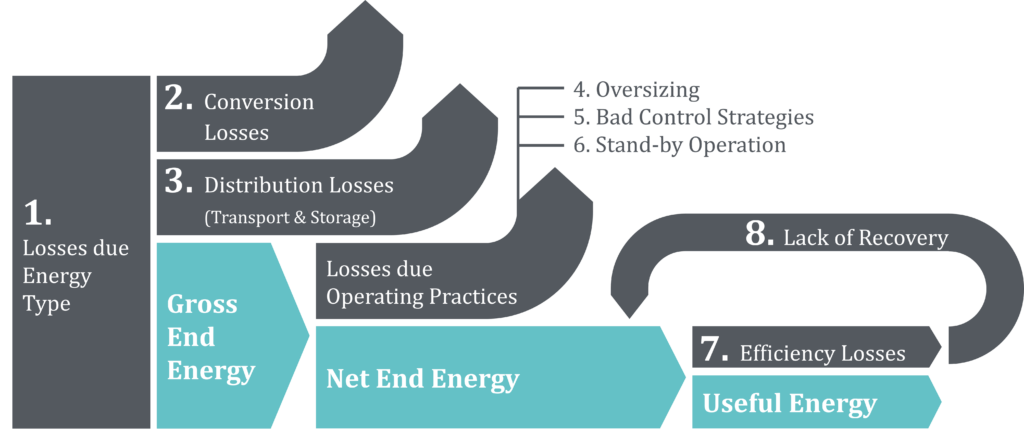Definition
Energy efficiency describes the ratio or other quantitative relationship between an achieved output or yield of services, goods or energy and the energy used.
DIN EN ISO 50.001
Strategies to Combat the 8 Types of Energy Waste

Energy efficiency can thus be increased if the energy requirement is reduced for the same output (in quantity, time and quality). According to (Erlach 2013, p. 46), the eight types of energy waste shown in the figure above can be distinguished.
If the physical structure is given, the energy efficiency of energy systems is primarily determined by the mode of operation, which influences different types of energy waste. The following principles can be derived for an operating strategy optimized purely according to energy efficiency criteria:
Use of Energy-Efficient Energy Sources
In principle, different (useful) energy carriers can be used for one and the same energy service (e.g. heating by electricity or natural gas). However, the equivalent primary energy demand can differ significantly due to the upstream energy conversion chain and transport losses. If the form of energy can be substituted dynamically during operation, the lowest-loss form should be selected from an EnEff perspective.
Use of Efficient Energy Converters
Often, a larger pool of equipment is available to provide the same energy service (e.g., different types of air compressors). Depending on the time of procurement, the components may not meet the latest energy efficiency standards (e.g., efficiency classes of electric motors IE1-IE4 according to IEC 60034-30-1). For energy efficient operation, equipment should be prioritized in terms of efficiency.
Use of Self-Generation and Environmental Energy
Due to decreasing investment costs for DER as well as environmental incentive schemes, self-generation and use of environmental energy is often worthwhile. Since the energy is utilized directly on-site and does not have to be routed through extensive transmission and distribution networks, self-generation and consumption usually turn out to be more energy efficient than gross grid purchases. (Pehnt 2010)
Avoiding Inefficient Operating Points
The efficiency of a plant is influenced on the one hand by manipulated variables (e.g. relative power if controllable) and on the other hand by environmental conditions (e.g. return temperature of the heat network for a heat generator, air temperature and relative humidity for an adiabatic recooler). If a system is operated outside the nominal point, the efficiency can be significantly impaired. Accordingly, the controllable influencing variables should be selected as far as possible so that efficient operating points are achieved.
Demand-Based Control of Useful Energy
Useful energy is often wasted when energy services are provided above the level actually required (e.g., overheating a room, changing air outside of times-of-use). The useful energy should always be reduced to a minimum level in line with demand. This implicitly includes demand-based control of the potential levels of energy networks in the next point.
Avoiding Energy Storage and Idling
Losses occur during storage and transport or transmission of energy (e.g., transmission heat losses in thermal storage systems, friction losses in flowing fluids in pipelines, leakage, etc.). Depending on the condition of the storage systems or pipeline networks, these losses can devalue a considerable proportion of the useful energy over time. As the state of charge of energy storage systems increases, which is influenced by potential variables (e.g. temperature, pressure), the power loss also generally increases due to the greater potential gradient with the environment. Over time, this leads to self-discharge of the storage devices. Furthermore, the process of storing and retrieving energy is associated with losses. Accordingly, from the point of view of energy efficiency, energy storage should be avoided wherever possible, unless it contributes to the recuperation of otherwise lost energy (see the following point). Unused (sub)systems for energy distribution should also, if possible, not be permanently supplied and should only be activated as needed (e.g., disconnection by shut-off valves).
Utilization of Recoverable Energy
If energy recovery systems are available, preference should be given to recoverable energy whose level is just sufficient for the technical application (e.g., low-calorific heat for low-temperature heating) before resorting to exergetically higher-quality energy sources (e.g., electricity, gas). This can also include the use of so-called incidental energy (waste heat from people, plants).
Sources
- DIN EN ISO 50001, 25.10.2011: Energiemanagementsysteme — Anforderungen mit Anleitung zur Anwendung.
- Erlach, Klaus (2013): Energiewertstrom – Steigerung der Energieeffizienz in der Produktion. In: Reimund Neugebauer (Hg.): Handbuch Ressourcenorientierte Produktion. München: Carl Hanser Verlag GmbH & Co. KG, S. 41–63.
- Pehnt, Martin (2010): Energieeffizienz. Ein Lehr- und Handbuch. Berlin, Heidelberg: Springer-Verlag Berlin Heidelberg.
